As an Amazon Associate I earn from qualifying purchases.
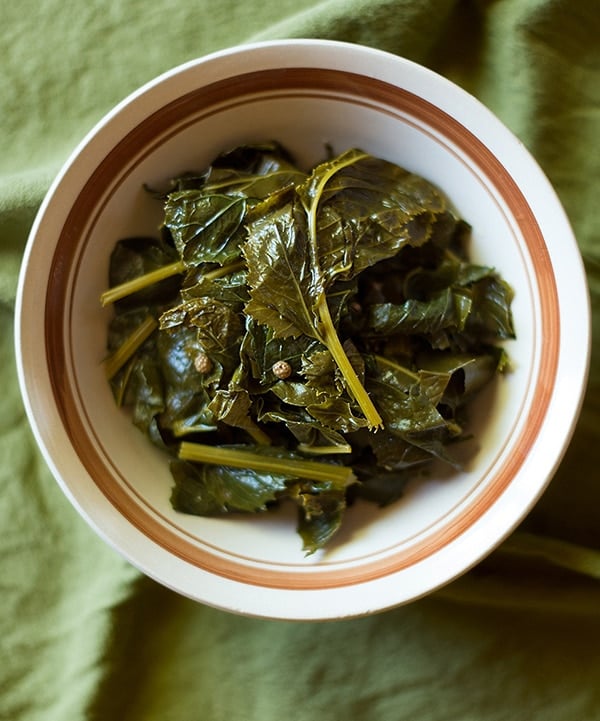
Ever since I began studying Chinese food some years ago, I noticed how much fermented and pickled foods factor into their cooking. Most of us know about Korean kimchi and many have had Japanese pickles before, but Chinese pickles are still relatively rare here in America.
One of my favorites — and one that can easily be done with wild food — is their ubiquitous pickled mustard greens.
Take a look around Chinese restaurant menus (not including the cheapy Chinese steam-table places) and you will see them. Often used in soups and stir-fries, pickled mustard greens come in various forms and styles. Many are pickled with vinegar, but some are old-fashioned brine pickles, which means the greens are fermented. That’s the kind I decided to make.
My recipe is an amalgam of a dozen or more I looked up in an assortment of Chinese cookbooks, notably Fuchsia Dunlop’s Land of Plenty: A Treasury of Authentic Sichuan Cooking and Eileen Yin-Fei Lo’s Mastering the Art of Chinese Cooking. Keep in mind this is a lacto-fermented pickle, so you will need a cool, dark place for it to do its thing. A quiet corner of the house is a good place, but not the refrigerator, which is too cold.
I ferment my greens (and pretty much everything else) with this set-up:
- Bowls to hold the mustard greens so you can weigh them.
- Something to pickle your mustard greens in. I happen to love these German style fermentation crocks. They’ve definitely upped my game in terms of lacto-fermenting things, and they look cool. You can also use quart Mason jars combined with narrow jelly jars to hold the greens under the brine.
- A kitchen scale. Every kitchen needs one, and you will want it to measure out an exact amount of salt. I’ll give you rough volumetric amounts in case you don’t have a scale, but the finished pickles may not be as good.
- Good pickling salt. Not iodized is key. Morton’s makes pickling salt that’s great, but any kosher salt will do. I prefer to use fine-grained French grey sea salt. Why? fine-grained salt dissolves easier, and the impurities in the sel gris, the gray salt, are other kinds of salt that add flavor. Not vital, but it’s a good choice.
- Spices. I use Tien Tsin chiles from Penzeys Spices for the dried chiles because that’s what you might use if you were in China. But any hot, dried chile works. I also sometimes add in Sichuan peppercorns. Star anise. You can buy it in many supermarkets, but you can substitute anise seed or even fennel seed.
How long you ferment is up to you. Minimum 3 days at room temperature, or you will wonder what the fuss is about. A week is good for beginners, but I prefer several weeks or even longer. The longer you go, the saltier and more pungent everything gets.
I ferment my greens for 3 weeks, which is an awful long time for some people, and not enough for others. The greens just looked right. How did I know this? Hard to say. I used The Force.

Whatever the power was that guided me, it did not steer me wrong. Pickled mustard greens are a flavor bomb. Pungent, because, well, they are mustard greens, spicy from chiles and Sichuan peppercorns, tangy from the ferment and crunchy-ish, too.
Not cracker crunchy, but the greens still had some bite to them, which was good. I was worried that the ferment might make them limp and slimy.
Some troubleshooting tips:
- If you get a weird mold on top, chances are the brine isn’t salty enough or some greens are floating on top. You need to remove that mold carefully. If you see black mold, toss the batch.
- Keep an eye on the brine level in your jars. Evaporation happens.
- Don’t ferment over 85°F, although given that we are talking about a cool weather green like mustard I don’t know how you’d be in that temperature. Regardless, slow fermentation is better here. I like it around 66°F to 68°F.
- When your pickled mustard greens are fermented to your liking — start tasting at 3 days — move them into the fridge, where they will keep until the Second Coming. Seriously. I’ve have some in the fridge for almost 2 years and they were fine.
You can use any sort of mustard, radish or turnip greens, but I used wild mustard. It grows with abandon around the farm fields in the Sacramento-San Joaquin Delta, and can be harvested by the grocery bag in minutes. Start looking for them here in NorCal in winter, sometime around Christmas.
If you are harvesting wild mustard — or garden mustard greens, for that matter — do so before your weather gets too hot. In most places, that means by mid-June at the latest. If you pick in hot weather, you will be sad: The leaves will be impossibly bitter. Better to wait for the fall crop than try to push things in July.
How to use these fermented beauties? I use them as the “green thing” in everyday stir-fries, and they are also really good in noodle soups. I suppose you could chop them and use them in a dumpling filling or just slap a leaf or two on a sandwich. If you come up with some other good uses, let me know.
Meanwhile, get out there and pick yourself some wild mustard! It’s there for the taking.
Pickled Mustard Greens, Chinese Style
Ingredients
- 3 quarts water
- 3/4 cup kosher salt (see instructions)
- 3 to 5 star anise
- 5 to 10 dried chiles, broken in half
- 1 tablespoon Sichuan peppercorns (optional)
- A 2-inch piece of ginger, sliced thin
- 1 cinnamon stick
- 2 tablespoons molasses or brown sugar
- 1 1/2 pounds mustard greens, cut into large pieces
Instructions
- Bring everything but the salt and mustard greens to a boil in a large pot. Turn off the heat and let it cool to room temperature. Pour everything into a vessel that you can weigh, and weigh the water plus spices in grams. Write this down.
- Wash you mustard greens well, then shake them dry and weigh them in grams. Write this down.
- When it's cool, weigh out 2 percent of the total weight of greens + water + spices in salt. Dissolve this in the liquid. If you use fine-grained salt you should have no problem. If the salt doesn't want to dissolve, stir until it does.
- NOTE: If you don't want to weigh all this out, just use the salt ratio I have in the ingredients list. It is approximately the same, but not exactly.
- Get out your fermenting crock or 5 quart-sized Mason jars with 5 narrow jelly jars to keep the greens submerged. You need this many because you will only pack the greens in 3/4 of the way into the jars -- you want at least 1 inch of brine above the level of the greens.
- Submerge the greens in the brine, using a chopstick or skewer to get rid of any air bubbles. Put the weights on the greens if you have them. If not, place the Mason jars in the sink and put the narrow jelly jars in them. The brine will overflow but the narrow jar will prevent the greens from contacting the air. Set the jars on a baking sheet and put in a cool place away from direct sunlight.
- Let them ferment at least 3 days, or longer. Mold may form eventually. This is normal. I wait until the mold cap is pretty solid, then pick it off. It's not harmful unless it's black.
- Finish by packing jars tight with the fermented greens, leaving about 1/2 inch of brine over them. Tighten the lids and put in the fridge. They will continue to ferment very slowly, so open the jars every week or two to release pressure. If you want to kill the ferment, boil the brine and cool before packing the jars the final time.
Notes
Nutrition
Nutrition information is automatically calculated, so should only be used as an approximation.

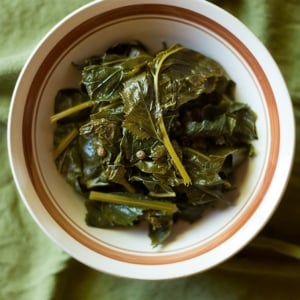
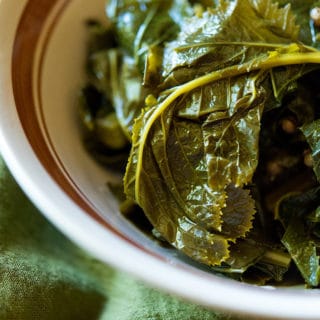
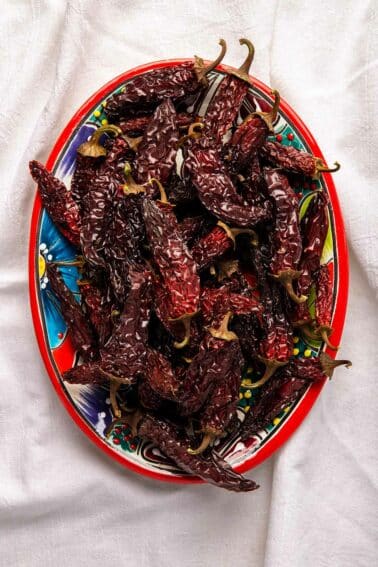
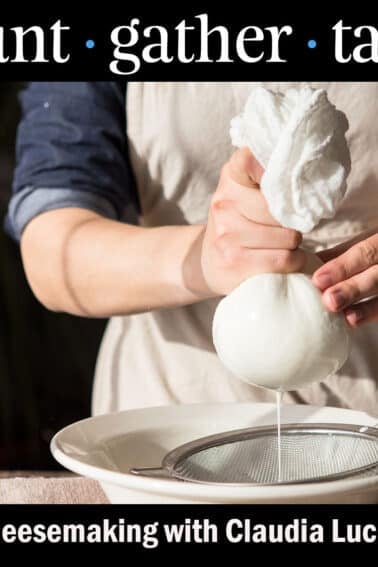


Would the pesky, invasive garlic mustard work for this? Would love to find a way to use it, it has pretty soft leaves.
Nancy: Yes it would. It’s also great in pesto.
Hank,
I would love to try fermenting some greens and veg but for some reason I’m very intimidated by the process. Can you recommend any good books for a novice?
Beth: Look up books by Sandor Katz.
I felt intimidated, too, at first and procrastinated for way too long. Now I am a fermenting junkie. It is just too easy not to do. Cultures for Health has many recipes free online. There are many other people now who have jumped on this bandwagon so there are oodles of recipes and articles for handling all kinds of veggies. I tried bok choy last year with a recipe I found as I felt unsure of doing leafy greens. They were wonderful and my current problem is where to store all the jars I want to make. Could use an entire dedicated refrig.
I also do not cook anything so find this recipe interesting. I will try it with the chinese mustard greens and wild mustards that are already ending their flowering. They are really quite mild. Am hoping to harvest the mustard seeds. I have gallons of lambsquarters in my garden now. Picked over a gallon just weeding my garlic plant rows yesterday and may try a combo or fermenting some and drying others. Do not be afraid. If the first batch is not to your liking, make it a learning experience and do again. The greens are free and the spices only a few cents.
No need for all the extra work. The most basic salted mustard greens: rub the whole leaves with salt. Rub salt into every part of leaves and stalks. For one big bunch, I used a couple of tablespoons of Himalayan salt. Let them sit for half hour or so. Rub againwith no more salt in another half hour. One more rub no more salt. Put them in jar with lid or in sealed gallon plastic bag. Refrigerate. Use within a week. Before use rinse 3 times, squeeze out water. Your salted greens should be a brilliant green. Chop and use in stir fries or soups.
Yeh: Sure, that sounds like a fine idea, but as you say, “use within a week.” My greens will keep for more than a year.
I started a batch of greens using a variation of this recipe this morning. I’ll follow up with the results later.
I ferment vegetables regularly so I thought I’d share some tips.
First, I use a powdered starter culture. Fermentation starts quickly before any bad stuff has a chance to grow.
Second, use bottled water. The low pH of some and lack of chlorine or it’s variants helps the good bacteria do their thing.
Third, I use half gallon Ball jars with an airlock lid. Air and excessive gas from the fermentation are allowed out but air and contaminants can’t get in.
The jars, lids, and starter culture are all available online. I get everything from Amazon.
I just moved my first batch from the Harsch pot to a container and it smells great. This one fermented for 2 weeks. I’m really pleased with the lack of any kind of mold/fungus inside the pot with this method. Now to find some recipes, because this produced a lot of greens!
I’m definitely going to do this with the mustard greens I have growing in the yard, but as I was thinking of other greens suitable for fermenting, I wondered if the Chaya was a good candidate? It contains Cyanide that has to be cooked at high temperatures for several minutes ( I do 13 minutes) to render the leaves safe to eat. Would fermenting also render the cyanide inert?
Anyway, I hated to post the question without doing some research and it appears that Cassava, which also contains cyanide, is routinely fermented. Does anyone have any experience with this?
Also, has anyone tried this recipe with a Harsch Pot?
Link to fermented cassava: https://www.fao.org/docrep/x0560e/x0560e06.htm
Chris: You must live somewhere tropical. Nope, I have no experience with chaya or cassava. Sorry!
i’ve tried fermenting collards with just salt and i see a bit of brown-ness on top. should i be worried? it’s very bubbly and looks like a typical ferment, sans the brown spots i see on top.
Can these femented greens keep in a cool basement?
Can they be frozen?
Refrigerator space limited; chinese mustard greens in garden unlimited
Chad: In this recipe I used Diamond Crystal. And the ratio isn’t THAT important, as it might be in sausage. It’s just that some people like to go “low sodium” on this sort of thing and cut it radically.
Your recipe really got me interested in fermented vegetables. Off your recipe, I am presently pickling arugula and rapini. I started a batch of turnip greens just using plain brine, so I could compare the flavor change to fresh turnip greens.
In your recipe, you stressed the importance of the salt to water ratio. So my question is which brand of Kosher salt do you use. The reason I am asking is because there is a large difference in the weight of various salts. For example, Morton’s Kosher salt weighs 7.5 ounces per cup and Diamond Kosher salt weighs 5 ounces per cup. At the 1 tablespoon of salt to 1 cup of water ratio in your recipe, based on weight, a brine with Morton’s would be 5.6% salt and Diamond would be 3.7%.
I have had a version of this on my list for a while, having read about pickled mustard in Naomi Duguid’s Burma: Rivers of Flavor. The shrink- wrapped version sold in my local Thai market is unappealing, so I hope to try my hand at these soon–before the heat zaps all greens in my area. Thanks for the reminder!
For the fermentation-phobic, the Washington Post food section has a vinegar-based recipe for Burmese style pickled mustard. https://projects.washingtonpost.com/recipes/2011/08/10/burmese-style-pickled-mustard-greens/
Hank, another question: Those wild mustard greens you used for this… do they have hairy/prickly stalks? I have some that came up in a garden bed, where I had other mustards before. Flowers are yellow and just like mustard flowers. Leaves shaped exactly like your photo — with prickles on the stalks.
I am going to try this method with every green I have. Now I am overwhelmed with (my favorite) collard greens from last year’s planting, from winter’s planting and spring planting! (those things grow fast and won’t die!).
I think I may try a batch using arugula leaves… the spiciest of all my greens.
This makes me so happy. I can just picture these on my Grandmother’s table. Thanks for sharing! I love when I see foraged versions of my childhood favourites.
I imagine garlic mustard would work just as well right?
What does a “roaring mold cap” look like, and how can you distinguish that it is not harmful?
Really delicious. I will try to make some with the mustards this weekend! I use a pickling liquid for garden produce-like cabbage and beans- tbat includes wodka (for want of the Chinese spirit) with similar ingredients but I’d replace the cinnamon here for cassia bark and include black cardamon pods, as they form tbe ‘fragrant things’ with the star anise and ginger.
I think this is a great pickle for nearly anything – definitely going to have to try it with our greens from the garden!
Looks great, could you replace the greens with ramps?
That’s pretty interesting with the molasses/brown sugar. Did any sweetness remain?